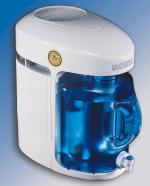Search engine visitors - click here to access entire "$ensible Home" web site
Click here to see a descriptive illustration of several designs of the best water filters and purifiers.
Dear Jim: Even though we drink municipal water, I am concerned about its purity and bioterrorism. I want an effective, high-quality filter system, not just a little carafe unit. What types are available? - Candi M.

A: There has been a definite spike in the use of water filters for drinking water since 9/11. Last year, more than one billion dollars worth of water filter/purifiers were sold. About 30 percent of Americans drink bottled water, but it is an expensive alternative to filtering your own.
The basic water filter/purifying methods are distillation, ozonation, reverse-osmosis (RO), carbon filter, and ultraviolet (UV). The most effective systems use a combination of these methods for improved taste too. There are real differences in effectiveness, so don't just buy the cheapest model on sale.
I use a countertop distiller and an ozonator in my own kitchen. Both these methods also purify the water in addition to improving the taste and removing unwanted chemicals or solids from the water.
Several companies make high-quality distillers which produce excellent drinking water. These boil the water and then the vapor condenses and drips into a pitcher. Since the water is boiled, bacteria and viruses are killed. A typical distiller produces about one gallon of pure water in four hours.
Select a model that also has a carbon filter element and an automatic shutoff. This allows you to remove a half-filled pitcher to use some water and then it automatically finishes the cycle. The drawback to a distiller is it uses about 25 cents of electricity to produce one gallon of water.
An ozonator produces ozone gas just like many municipal purification plants use. You place a bubbler in the water and turn on the small ozonator for five to 60 minutes depending on the volume. Ozone dissolves in the water, purifies and improves its taste and then turns back into simple oxygen.
For several minutes after water is treated, there is a residual dissolved ozone level. You can ozonate a bowl of water for washing fruits, vegetables, meats, etc. to kill dangerous bacteria and viruses and keep them fresher longer.
RO water filters are usually mounted underneath the sink with a spout through the countertop. They are an effective method and often also include a carbon element. Their drawback is they produce water slowly and they waste several gallons of water for each filtered gallon.
Large carbon element filters use a carbon block to filter and remove chemical impurities from water. UV units use a UV light to kill organism. New countertop and freestanding water cooler/hot water dispensers use a combination of a fine filter, UV and carbon. They also have an optional carbonated water spout.
Instant Download Update Bulletin No. 569 - buyer's guide of the best 16 water filter and purifier manufacturers, descriptions of the filtration methods, styles (countertop, under-counter, faucet, water bottle) of the various models, features, prices, many illustrations of models, and two charts showing the recommended filtration methods for hazardous contaminants and common water problems.
Dear Jim: My house is small and we are cramped for space. I was thinking of mounting my electric dryer upside down from the ceiling above the washer. Does this make any sense and will the dryer work like this? - Carol D.
A: An electric dryer probably would not run well in an upside down position. The supporting structure inside of it is designed to resist the forces from gravity. They would all be reversed in that position.
You can either buy a new front-loading washer and stack the dryer over it or build a wide support stand to hold the dryer over your washer. Have a professional carpenter design and build it because a dryer is heavy.